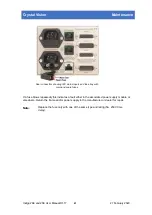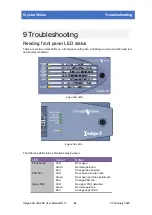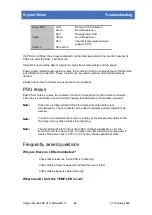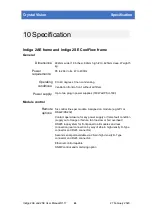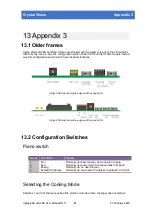
Crystal Vision
Appendix 2
MIB tree
Object identifiers (OID)
For each variable to be monitored there is an object identifier or OID which can be distinguished
from any other OID within the MIB by its unique bit number.
As an example, the Front panel open status for the frame with slot addresses set to Lower (see
section 2.4 for an explanation of slot addresses) is recorded by the OID
1.3.6.1.4.28681.
1
.2.1.
5
.
1
where
1
is the board type (Frame), the
5
is the bit number (Frame
open) and the final
1
indicates that the frame slot addresses are set to lower. If the frame was
set to upper slot, addressing the OID would be 1.3.6.4.28681.
1
.2.1.5.
2
. The OID will then be
accompanied by a value to indicate its status. Any status change will cause the transmitting of a
trap to the SNMP manager.
Note:
The SNMP monitor allows for two frames to be connected as a frame pair. The
second frame will be reported as Unknown when not present.
The frame variables monitored are:
Name
Value
Name
Value
Frame Present 1
Frame PIC found/not
found
PSU Present 1
Found/not yet found
Frame Present 2
Frame PIC found/not
found
PSU Present 2
Found/not yet found
Frame Type 1
Reserved/unknown
PSU Present 3
Found/not yet found
Frame Type 2
Reserved/unknown
PSU Present 4
Found/not yet found
Frame Temperature 1
Integer (temp)
PSU Type 1
PSU-160i/unknown
Frame Temperature 2
Integer (0)
PSU Type 2
PSU-160i/unknown
Frame Open 1
Front panel
open/closed/unknown
PSU Type 3
PSU-160i/unknown
Frame Open 2
Front panel
open/closed/unknown
PSU Type 4
PSU-160i/unknown
Frame PSU Fan
Status 1
PSU fan
OK/problem/unknown
PSU Status 1
PSU
OK/problem/unknown
Frame PSU Fan
Status 2
PSU fan
OK/problem/unknown
PSU Status 2
PSU
OK/problem/unknown
Indigo 2AE and 2SE User Manual R1.17
73
27 February 2020



